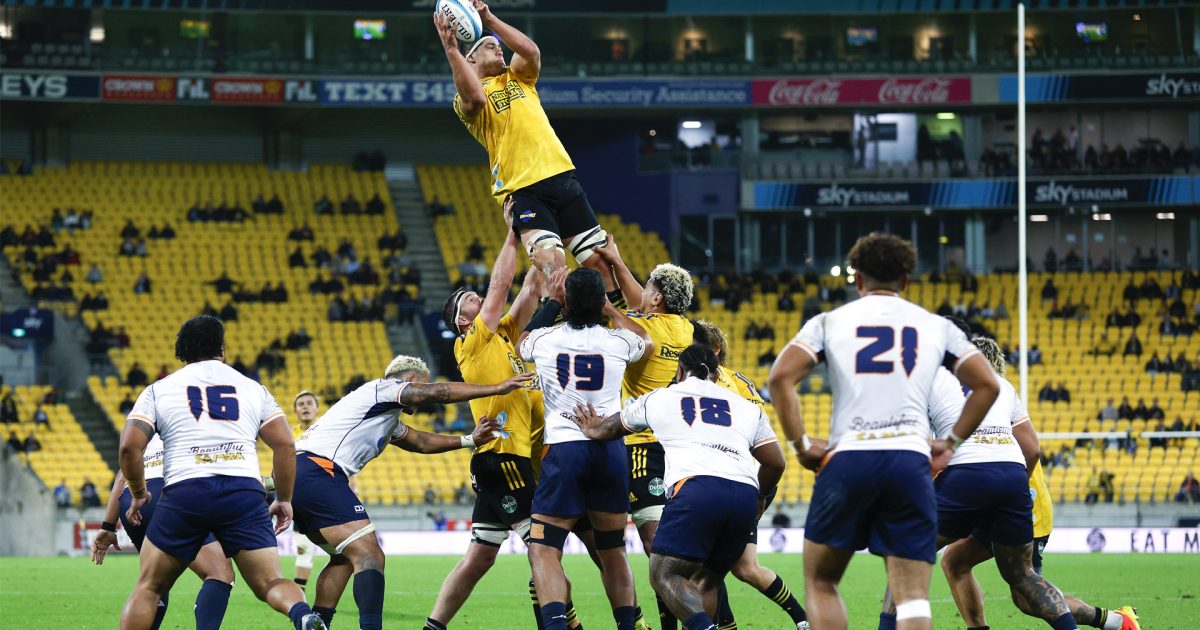An easy fix to empty stadiums that are killing the Super Rugby spectacle

There were two very key lessons dished up in Round 11 of the Super Rugby Pacific season.
The first, and most obvious, is that there’s a much narrower chasm between the quality of the New Zealand teams and their Australian opposites. The Brumbies and Waratahs both banked wins over the weekend while the Reds, Drua and Force came remarkably close to grabbing scalps.
It would still take a brave man to bet against five NZ sides making the quarter-finals but there are at least signs that a respectable competition could emerge over the coming seasons.
The second, perhaps more interesting lesson for tournament organisers, is that there’s massive value in hosting matches at smaller venues.
The two Saturday afternoon fixtures, between the Drua and Highlanders in Suva, and the Waratahs and Crusaders in Lilyfield, were played in front of heaving venues outside of the main centres that have dominated Super Rugby fixtures in recent years.
Over 15k spectators were on hand at a sold-out ANZ Stadium to witness the Drua’s first-ever home game and they came close to buoying their team to a victory in Fiji. Meanwhile, in the outer suburbs of Sydney, 10k fans turned out to witness a remarkable win for the home side over the much more fancied Crusaders.
Playing matches in smaller stadiums is somewhat of a foreign concept in the Southern Hemisphere.
Of the New Zealand franchises, the Crusaders are the only team to play home matches in a stadium that boasts fewer than 20k seats. Forsyth Barr Stadium and Sky Stadium both have room for over 30k fans while Eden Park can support 50k. Even Moana Pasifika, the newest franchise based in NZ, play their home games at a venue built for 30k.
Across the ditch in Australia, no regular home venue caters to fewer than 20,000 fans with the Rebels, Reds and Waratahs (from next season) hosting their matches at stadiums that can support over 30k.
Head up to England, however, and the vast majority of venues are considerably smaller and more intimate.
10 of the 13 Premiership sides play in venues that cater to fewer than 20,000 attendees. Despite many of the clubs boasting smaller immediate populations than teams in NZ and Australia (e.g. Northampton, with a population of 225k, is smaller than nine of the 12 locations for Super Rugby Pacific sides), they are able to regularly hit over 80 per cent of capacity. For Super Rugby sides, that would be a dream result.
In 2019 – before Covid made attending matches considerably more complex – New Zealand Super Rugby derbies averaged crowds of 10 to 20k, with the vast majority sitting below the 15k mark. Games hosted in NZ that featured international sides gravitated closer towards 10k, with some not hitting that mark. It was a similar story in Australia, with stadiums regularly sitting at less than one-third full.
The simple reality is that there’s an abundance of tickets available to Super Rugby matches – there’s rarely any competition for seats. If you want to buy a ticket on the day of a match, that’s usually very achievable. Some might suggest that’s a positive but it really just shows how unimpressive the live game experience is.
There’s an abundance of ways the spectacle of rugby can be improved but perhaps the simplest method would be to shift games to smaller stadiums.
When upwards of 80 per cent of seats are filled, the atmosphere ramps up a notch – both for players and for fans. It makes the game a more enjoyable experience and keeps supporters wanting more. The biggest impact would be on those in attendance but it would also amp up the experience for those at home who week after week after forced to stare at the vacant yellow seats of Sky Stadium in Wellington.
For various reasons, we’re unlikely to see games shifted away from the major venues in New Zealand and Australia anytime soon – primarily long-term agreements that exist between the various Super Rugby franchises and their primary stadiums – but there’s reason to belief that a move to smaller stadiums could reignite the interests of fans. Save the likes of Eden Park and Fosyth Barr for the bigger events – major grudge matches or knockout fixtures, but take the bulk of the games to venues that can be filled to the brim.






































































I'd like the ref mike over the stadium speakers, and any conversation with the TMO to come into the stadium.
That's one area that TV audiences get a better deal. And if the crowd do manage to get going, stop the piped music and let them keep going.
Night games mean the players, fans, and tv audience are half asleep by the end of the game. 7 pm is bad enough, but the Aussie games start at 8 pm, and 10 pm our time!
Why don't they play the game in the afternoons. Like the good old days.
N play club rugby at night.
By the time I get the kids back home after the game it's 1130pm way pass their bed time.
Easier to sit infornt of fire n watch game on TV. Plus the food n refreshments are cheap as at home.
This seems a no brainer. Even NPC games get decent crowds at smaller venues.